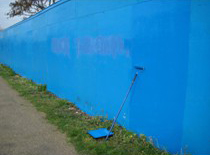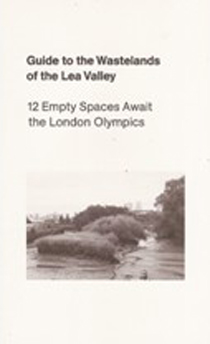
East End VS Olimpic Park, by Massimiliano Scuderi |
 |
We have come to accept that an area chosen to be the scene of a new urban development project is defined as an “urban void”, but the East End of London, which is destined to contain the Olympic Village of 2012, and above all its community, especially the most lively and creative part of it, does not intend to remain passive as regards decisions that will determine the future orientation of the area. In an article that appeared in The Guardian (1), Rushanara Ali describes how the 2012 Olympics were greeted enthusiastically by Londoners in general and, in particular, by the inhabitants of the area which foresaw in the event new development opportunities and jobs for the young, manna from heaven in a period of recession caused by the planned cuts of Prime Minister David Cameron to reduce public spending. Ms. Ali describes the carelessness of the Commission which was named to manage the event, the Locog (2), that heralded the Games as a moment of social inclusion, promising 6,000 jobs for the residents of the Tower Hamlets and Hackney neighbourhoods. In the end the opportunities turned out to be more limited and the number of jobs reduced to a meager 334. For some tenders even the procedure which had been planned initially was changed, with negative consequences for local entrepreneurs who had willingly invested to offer their services to the people of the Olympics. Facing this reality the local community has mobilized, to pluck their situation from limbo and from the centralizing vision which is inattentive to the needs of the neighbourhoods, to defend their existence and avoid the complete removal of the identifying characteristics of the area. This is an area that, by inclusivity and culture, has managed to redefine itself, from disreputable to a place of culture, and to claim its role as a part of the city. One must remember the importance of the creative community in developing this part of London. Between the end of the ‘80s and the early ‘90s they moved their studios and galleries from the centre to East End, as an answer to Thatcher’s policies and, above all because the new avant-garde needs to appropriate the most vital and interesting alternative spaces, to do their research, but also to gather the realities and moods of the area in which they were settling. The climate of multiracial and cultural tolerance quickly made the new settlement a success, to the point that it became a model used as an international benchmark. Among the most interesting studies on the theme, on cultural hybridness and on the relationship between the government and social minorities, surely the concept of third space by the philosopher Homi Bhabha (3) explains the strategies to decode the social and behavourial languages of these neo-communities that are located diversely and use creatively the codes which, at the beginning, copy mimetically only the form.
Those who inhabit East End today do not consider it necessary to renounce to their identity and oppose the government’s vision that would cancel the peculiarities of their neighbourhoods, stratified with stories and significant locations which can not exist in the definition “urban void”. And it is precisely the creative community that, together with the local inhabitants, has given life to an intelligent media response in answer to the logic underlying this new brand of Olympics. In an article by Andrea Pavoni (4) we find a list of the initiatives undertaken by some of these artists making their claim to diversity within the urban landscape of the East End, a diversity quite in contrast to the unilateral vision of the Olympic planners. Among the projects that aim to mobilize public opinion and stimulate new planning, “The Big Blue Fence”, an initiative by Penny Cliff and Christopher Preston, inspired by anguishing presence of the continuous blue wall cordoning off the area of the future Olympic Park, which cannot but remind us of the Cold War walls which divided cities. The initiative serves to give the inhabitants who will live there after the Olympics, the opportunity to remember the stories of their neighbourhoods. Then there are other projects such as “Go for Gold!” by Gesche Würfel whose aims to document the relationships between the inhabitants and their built up surroundings, in relation above all to the ongoing changes in the urban environment. Other interesting projects, treat the themes of the physical and significant gentrification and the emptying of the areas affected by the Olympics “Olympyon Visions” by the photographer Alessandra Chile and “”Guide to the Wastelands of the Lea Valley, 12 Empty Spaces Await the London Olympics” by the artist Lara Almarcegui, which asks to maintain portions of the empty spaces, within the new plans foreseen for the area, a romantic and significant appeal, but a feeling present throughout the area.
Last but not least “All Aboard” by Jim Thorpe which records the ongoing changes in the workplaces in the area, in the public and private spaces, involving the local community. As Ezra Pound said, “artists are the antennae of the race”. This time the antennae of England’s creative community have become unusually long. Though large investments were found for the ArcelorMittal Orbit by the Anglo-Indian artist Anish Kapoor, a muscular sculpture that will stand a record 115 metres tall and will be inaugurated at the opening of the Games, the future of culture in the city is not all that rosy. In a recent report in the review Art Newspaper, we find listed the amounts that Cameron’s Government will allocate to culture and even important institutions like the Tate Britain, will have to wait until 2012 to receive from the Secretary of Culture Jeremy Hunt the £80m of funding it has been promised.





